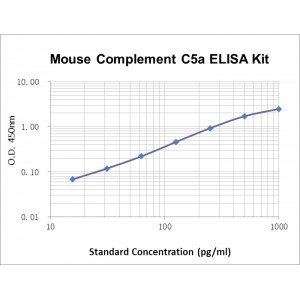More info
Assay Range | 15.6--1000 pg/mL |
Sensitivity | 10.0 pg/mL |
Size | 96T |
Storage | Store at 2 - 8ºC. Keep reconstituted standard and detection Ab at -20 ºC |
Assay Principle | Sandwich ELISA |
Sample volume | 100 µL final volume, dilution factor varies on samples. |
Detection Method | Chromogenic |
Kit Components
1. Recombinant Mouse C5a standard: 2 vials.
2. One 96-well plate precoated with anti-Mouse C5a Ab
3. Sample diluent buffer: 12 mL - 1
4. Detection antibody: 130 µL, dilution 1:100.
5. Streptavidin-HRP: 130 µL, dilution 1:100
6. Antibody diluent buffer: 12 mL x1
7. Streptavidin-HRP diluent buffer: 12 mL x1
8. TMB developing agent: 10 mL x1
9. Stop solution: 10 mL x1.
10. Washing solution (20x): 25 mL x1.
Background
Complement 5a (C5a) is a glycoprotein belonging to the anaphylatoxin family. Human C5a is a 74 amino acid (aa) peptide derived from C5 α chains by C5a convertase. It is composed of four helices and connected by peptide loops with three disulphide bonds between helix IV and II, III. C5a is rapidly metabolised by carboxypeptidase B to a 72 aa form termed C5a des-Arg without C-terminal arginine. Mouse C5a shares 60% and 82% aa sequence identity to human and rat C5a, respectively.
As an anaphylatoxin, C5a plays a role in promoting expression of adhesion molecules on endothelium, contraction of smooth muscle, and increasing vascular permeability. Both C5a and C5a des-Arg can trigger mast cell degranulation, releasing proinflammatory molecules histamine and TNF-α. C5a is also an effective chemoattractant to initiate accumulation of complement and phagocytic cells at sites of infection or recruitment of antigen-presenting cells to lymph nodes. C5a plays a key role in increasing migration and adherence of neutrophils and monocytes to vessel walls. C5a also modulates the balance between activating versus inhibitory IgG Fc receptors on leukocytes, thereby enhancing the autoimmune response. C5a binds to a signaling G protein coupled receptor (C5aR/CD88) and a non-signaling GPCR termed C5L2. Activation of CD88 results in neutrophil chemotaxis and endothelial cell activation.


